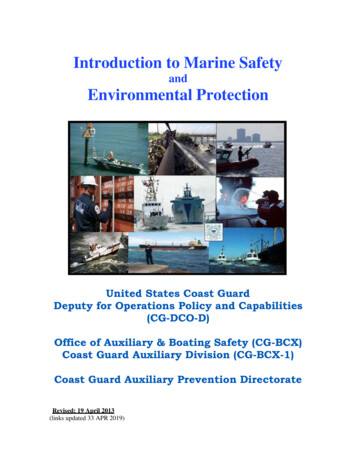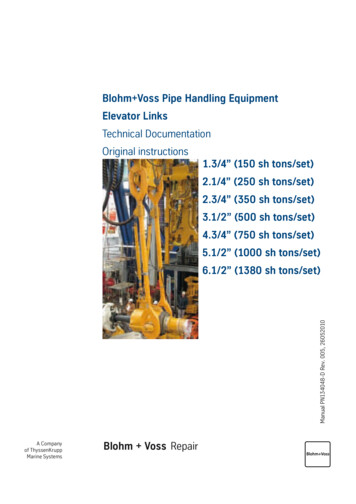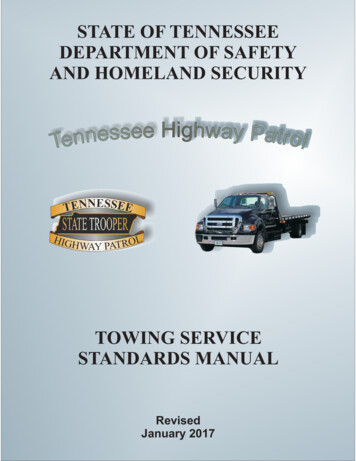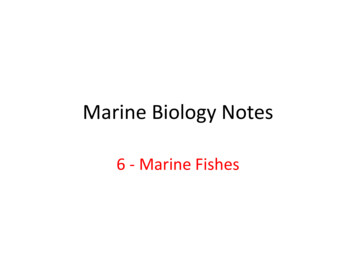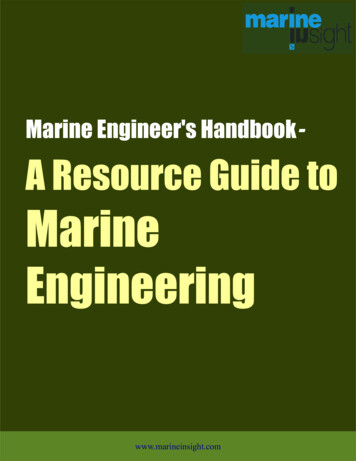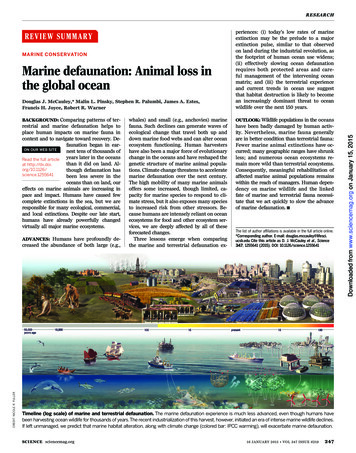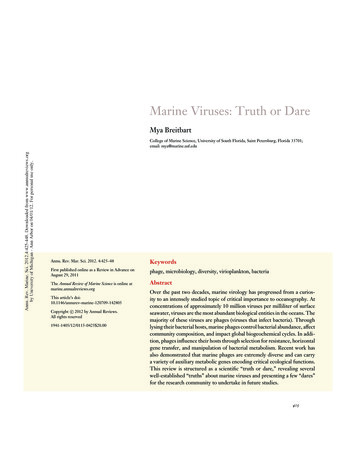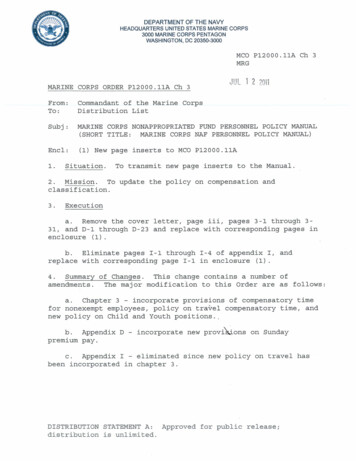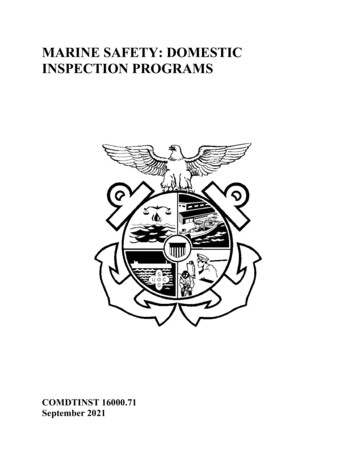
Transcription
MARINE SAFETY: DOMESTICINSPECTION PROGRAMSCOMDTINST 16000.71September 2021
CommandantUnited States Coast GuardUS Coast Guard Stop 75012703 Martin Luther King Jr. Ave SEWashington, DC 20593-7501Staff Symbol: CG-CVCEmail: CG-CVC@uscg.milCOMDTCHANGENOTE 1600020 SEP 2021COMMANDANT CHANGE NOTICE 16000Subj:CH-3 TO MARINE SAFETY MANUAL VOLUME II, COMDTINST M16000.7B1. PURPOSE. This Commandant Change Notice publishes the cancellation of Marine SafetyManual Volume II, COMDTINST M16000.7B, and replacement with separate CommandantInstructions, one for each chapter of the existing Manual.2. ACTION. All Coast Guard unit commanders, commanding officers, officers-in-charge,deputy/assistant commandants, and chiefs of headquarters staff elements shall comply with theprovisions of this Commandant Change Notice. Internet release is authorized.3. DIRECTIVES AFFECTED. With the addition of this Commandant Change Notice, MarineSafety Manual Volume II, COMDTINST M16000.7B, is cancelled.4. DISCUSSION. The content of Marine Safety Manual remains intact. The primary reason forthis change is to allow for timely revision and re-publication of the individual CommandantInstructions.5. DISCLAIMER. This guidance is not a substitute for applicable legal requirements, nor is ititself a rule. It is intended to provide operational guidance for Coast Guard personnel and isnot intended to nor does it impose legally-binding requirements on any party outside the CoastGuard.6. MAJOR CHANGES. Sections A though G of Marine Safety Manual Volume II,COMDTINST M16000.7B, are now individual and independent Commandant Instructions.They are listed below.a. Marine Safety: Marine Inspection Administration, COMDTINST 16000.70 (pages A1-1 A7-43)DISTRIBUTION - SDL No. 170abcdefgABCDEFGHxijkxxxhxxxNON-STANDARD DISTRIBUTION:xxlxmnxxopqxrstuvwxyz
COMDTCHANGENOTE 16000b. Marine Safety: Domestic Inspection Programs, COMDTINST 16000.71 (pages B1-1 –B10-3)c. Marine Safety: Inspection of Engineering Systems, Equipment, and Materials,COMDTINST 16000.72 (pages C1-1 – C5-31)d. Marine Safety: Port State Control, COMDTINST 16000.73 (pages D1-1 – D7-38)e. Marine Safety: International Conventions, Treaties, Standards, and Regulations,COMDTINST 16000.74 (pages E1-1 – E4-3)f. Marine Safety: Carriage of Hazardous Materials, COMDTINST 16000.75 (pages F1-1 –F5-35)g. Marine Safety: Outer Continental Shelf Activities, COMDTINST 16000.76 (pages G1-1 –G6-24)7. ENVIRONMENTAL ASPECT AND IMPACT CONSIDERATIONS.a. Commandant CG-47 reviewed the development of this Instruction, and the generalpolicies contained within it, and determined that this policy falls under the Departmentof Homeland Security (DHS) categorical exclusion A3. No further environmentalanalysis is necessary in accordance with the U.S. Coast Guard Environmental PlanningPolicy, COMDTINST 5090.1 (series).b. This Instruction will not result in any substantial change to existing environmentalconditions or violation of any applicable federal, state, or local laws relating to theprotection of the environment. It is the responsibility of the action proponent to evaluateall future specific actions resulting from this policy for compliance with the NationalEnvironmental Policy Act (NEPA), other applicable environmental mandates, and theU.S. Coast Guard Environmental Planning Policy, COMDTINST 5090.1(series).8. DISTRIBUTION. No paper distribution will be made of this Commandant Change Notice. Anelectronic version will be located on the following Commandant (CG-612) web sites. Internet:http://www.uscg.mil/directives/, and ives/SitePages/directives.aspx9. PROCEDURE. Cancel Marine Safety Manual Volume II, COMDTINST M16000.7B and replacewith COMDTINSTs 16000.70 thru 16000.76.10. RECORDS MANAGEMENT CONSIDERATIONS. Records created as a result of thisInstruction, regardless of format or media, must be managed in accordance with the recordsretention schedules located on the Records Resource Center CGPortal itePages/Home.aspx.11. FORMS/REPORTS. The forms called for in this Commandant Change Notice are available inUSCG Electronic Forms on the Standard Workstation or on the Internet:https://www.dcms.uscg.mil/forms/; CGPortal s/Forms.aspx; and Intranet athttps://www.dcms.uscg.mil/forms/.2
COMDTCHANGENOTE 1600012. REQUEST FOR CHANGES. Request for changes to the previous mentioned CommandantInstructions may be sent to Commandant (CG-CVC) at HQS-SMB-COMDT-CGCVC@uscg.mil./J. W. MAUGER/Rear Admiral, U. S. Coast GuardAssistant Commandant for Prevention Policy3
COMDTINST M16000.7BUSCG Marine Safety Manual, Vol. II: Materiel InspectionSECTION B: DOMESTIC INSPECTION PROGRAMSCHAPTER 1: INSPECTION OF VESSELS FOR CERTIFICATIONA.INTRODUCTIONThis chapter of the Marine Safety Manual (MSM) provides guidance regarding inspections forthe issuance of a Certificate of Inspection (COI), as well as information concerning variousdecisions and interpretations of regulations. This guidance is supplemented by references toother sections of the MSM, which have additional information. The responsibilities of theOfficer in Charge, Marine Inspection (OCMI) and inspection personnel are discussed in theMSM, Volume I, Administration and Management, COMDTINST M16000.6 (series).B. CERTIFICATION OF VESSELS1. General Provisions46 U.S.C. Chapter 33 requires that certain vessels possess a COI. The issuance of a COIdepends on the vessel’s satisfactory completion of an inspection for certification. A vessel’sretention of the COI depends on the continued maintenance of the vessel in a safe operatingcondition. When satisfied that the vessel in question complies with all applicable statutesand regulations and can be operated safely without endangering life or property, the OCMI isauthorized to issue a Permanent COI of a Temporary COI, Form CG-854, pending issuanceof the permanent COI. Both permanent and temporary COIs are generated by the MarineInformation for Safety and Law Enforcement (MISLE) database.NOTE: The initial COI may be completed before issuance of the Certification ofDocument (COD). The COI should be issued, provided the National Vessel DocumentationCenter (NVCD) has received the application for documentation.Contact the NVCD about vessel documentation questions.a. Government owned vessels. Government owned vessels may be subject to maritimeand environmental safety laws. To determine if a regulation applies to governmentvessels, one should check the applicability sections of the applicable CFR subchapter.B1 - 1
COMDTINST M16000.7BUSCG Marine Safety Manual, Vol. II: Materiel InspectionSECTION B: DOMESTIC INSPECTION PROGRAMSCHAPTER 1: INSPECTION OF VESSELS FOR CERTIFICATIONb. Jones Act requirements for coastwise U.S. trade. Vessels engaged in coastwise orGreat Lakes trade must be U.S.-built vessels. For a vessel to be considered a U.S.built vessel, it must have been constructed totally within the United States. Thisincludes fabricated structural vessel components; there is no allowance for fabricationof even a small portion of major components outside of the United States.NOTE: Construction materials that are otherwise processed per detailed instructions so asto permit simplified assembly with nominal preparation will normally be consideredfabricated.2. Periods of Validitya. Introduction. The periods of validity for a COI vary by vessel type and are specifiedwithin the applicable regulations. In general, they are as follows:(1) 1 year for passenger vessels on all routes, small passenger vessels that engage oninternational voyages, Nautical School Ships, and nuclear powered vessels.(2) 5 years for cargo, tank, oceanographic research, small passenger vessels engagedexclusively on domestic voyages, and miscellaneous vessels.b. COIs are normally issued for the maximum period specified in the applicableregulations. A vessel is certificated on its ability to meet the minimum safetystandards set forth in the regulations. Under existing law, any vessel that meets thesestandards is entitled to a full-term COI.c. A vessel that is unable to meet the minimum standards must correct its deficienciesprior to certification or, if the deficiencies are minor and do not make operation of thevessel unsafe, be granted reasonable time in which to make the necessary corrections.d. An owner may surrender the COI and apply for inspection for recertification at anytime prior to the expiration date.e. The conditions under which certain vessels on foreign voyages may return to theUnited States with expired certificates are discussed in Paragraph C.7 of this chapter.f. Vessels with expired COIs. A vessel with a COI that has lapsed, regardless ofcircumstances or reasons, may be required to undergo inspection for certification as anew vessel if the owner/operator desires to place the vessel back into certificatedservice.B1 - 2
COMDTINST M16000.7BUSCG Marine Safety Manual, Vol. II: Materiel InspectionSECTION B: DOMESTIC INSPECTION PROGRAMSCHAPTER 1: INSPECTION OF VESSELS FOR CERTIFICATION(1) The cognizant OCMI will make a determination as to the type and extent ofinspection requirements appropriate after giving due consideration to thecircumstances behind the vessel’s out-of-service period.(2) When making this the determination, the OCMI must closely evaluateenvironmental conditions such as operations in fresh water, salt water, or drydocklay-up as well as any structural modifications made to the vessel.g. Grandfathering. The OCMI may, at his or her discretion, require a formerlycertificated vessel to be inspected as a new vessel regardless of its former status as acertificated vessel. Such vessels would no longer be afforded exemption fromregulatory requirements under grandfather provisions provided by law, regulation, orpolicy.h. A vessel that was once certificated does not qualify indefinitely as an “existing”vessel, especially when it has been structurally modified and/or out of service for anextended period. A vessel whose COI has lapsed will be required to meet thoseinspection for certification requirements determined to be appropriate by the issuingauthority—the OCMI.i. 1-year certificates. Regulations permit the issuance of certificates to certain cargo,tank, and miscellaneous vessels for periods of less than 2 years. Examples are 1-yearcertificates for-(1) Vessels equipped with firetube main propulsion boilers, including riveted lapseam boilers;(2) Vessels that, in the OCMI’s opinion, should be inspected on a 1-year basis byreason of route (the Commandant's approval must be obtained in these cases); and(3) Nuclear powered vessels.3. Entries on COIsa. Number of passengers stated. Except for ferryboats, the OCMI is responsible fordetermining the number of passengers that a vessel has accommodations for and cancarry with prudence and safety, as provided for in 46 U.S.C. 3501. That number mustbe stated on the COI. The OCMI must not permit the number of passengers allowedto exceed that permitted by law or regulation, or specified in the vessel's stabilityletter.b. Maximum number of passengers on ferry vessels. See 46 U.S.C. 3501 Notes ofDecisions, for guidance on how to compute and list the number of passengers andcrew on the COI for ferry vessels. 46 U.S.C. 3501 notes that “ respecting thenumber of passengers that may lawfully be carried by a passenger steamer,B1 - 3
COMDTINST M16000.7BUSCG Marine Safety Manual, Vol. II: Materiel InspectionSECTION B: DOMESTIC INSPECTION PROGRAMSCHAPTER 1: INSPECTION OF VESSELS FOR CERTIFICATION[46 U.S.C. 3502] have no application to a ferryboat, though temporarily employed asan excursion boat.”(1) Essentially, 46 U.S.C. 3501 considers ferry vessels to be cargo vessels, notpassenger vessels. Accordingly, the number of passengers and crew authorized ona ferry vessel is not required to be listed on the COI.(2) However, many ferry vessels are a combination of both cargo and passengervessels. As such, when the OCMI and the owner of a ferry vessel agree on thenumber of passengers that can be carried safely, and when the owner of the ferrydesires it, the maximum number of passengers permitted may be entered on theCOI.c. Tankships carrying grain cargo. No COI amendment is necessary for a tankship tocarry grain cargo. The Federal Grain Inspection Service provides inspectors tooversee loading of vessels with grain.NOTE: When stability is a factor in limiting the maximum number of persons that can becarried with safety on any ferry vessel, the total number of persons permitted aboard mustbe stated in the stability letter.4. Temporary COIsA Temporary COI, Form CG-854, provides evidence of the satisfactory completion of aninspection for certification (see 46 U.S.C. 3309). It stands in lieu of a COI and, until replacedby a COI, has all the force and effect of the permanent certificate. The temporary certificateis intended for use when the immediate issuance of a COI is not possible at the completion ofan inspection. It is not the Commandant's intention that a COI should be withheld pendingcorrection of minor deficiencies after a temporary certificate has been issued. Further, whenthe permanent COI can be issued in time to meet the vessel's needs, a temporary certificateshould not be issued.B1 - 4
COMDTINST M16000.7BUSCG Marine Safety Manual, Vol. II: Materiel InspectionSECTION B: DOMESTIC INSPECTION PROGRAMSCHAPTER 1: INSPECTION OF VESSELS FOR CERTIFICATION5. Seasonal RestrictionsSeasonal limitations are intended to ensure the overall seaworthiness of the vessel and thesafety of the passengers carried under differing operational conditions, without completelyhalting the operation of the vessel during any specific period of time. COI statements ofseasonal restrictions must be as descriptive as possible, showing limitations on vessel routes,the scope of passengers carrying authorizations, and the like.6. Certificates Expiring at Seaa. COI extensions. There are no statutory provisions that allow for the extension of aCOI. Accordingly, requests for extensions of certificates must be denied.b. Expirations of COIs during foreign voyages. Under 46 U.S.C. 3314, a vessel maycomplete a foreign voyage to a port of the United States within 30 days of theexpiration of its COI without incurring penalties for operating without a validcertificate.(1) The vessel owner/operator must apply for an inspection for certification at thefirst U.S. port of call.(2) The vessel must then complete an inspection for certification, and a new COI or aPermit to Proceed will be issued, if an inspection for certification has beenconducted to the point that the OCMI considers the vessel safe to proceed on thevoyage. (See MSM Volume II, Material Inspection, COMDTINST M16000.7(series), Chapter A6 for more details.)c. Vessels sailing less than 15 days prior to expiration of COI. 46 U.S.C. 3314 preventsthe grace period described above from being applied if the COI would expire within15 days of the date of sailing from a U.S. port. A vessel would not violate thisprovision merely by sailing to a foreign port within 15 days of the expiration of theCOI, provided it returns to a U.S. port before the COI expires. Such a vessel would bein violation if it sailed within 15 days of the expiration date and failed to return beforeexpiration of the COI.7. Marking of Hailing PortsUnder 46 CFR 67.123, a hailing port must be marked on some clearly visible exterior part ofthe stern of a documented vessel. The markings must be durable and made in clearly legibleletters of the Latin alphabet or Arabic or Roman numerals of no less than 4 inches in height.B1 - 5
COMDTINST M16000.7BUSCG Marine Safety Manual, Vol. II: Materiel InspectionSECTION B: DOMESTIC INSPECTION PROGRAMSCHAPTER 1: INSPECTION OF VESSELS FOR CERTIFICATION8. Towing of Vessels Permanently Laid-Up, Dismantled, or Out-of-Commissiona. Vessels are frequently towed for purposes of permanent removal from navigation orscrapping as these vessels reach the end of their useful lives. It has been generallydetermined that such vessels making a one-way voyage under tow; without crew,cargo, or passengers; and not holding documents as a merchant vessel, are not subjectto inspection and certification requirements. Such vessels are "laid up, dismantled, orout of commission" under 46 U.S.C. 3302(e) and 46 CFR 90.05-1(a)(3). Inaccordance with this determination, when the OCMI is satisfied by documentaryevidence or other means that certain conditions are met, such vessels do not require aCOI. These conditions may include some or all of the following:(1) The vessel is not currently documented by the Coast Guard.(2) The vessel will carry no passengers or cargo.(3) The vessel will be towed and unmanned.(4) The vessel is making a one-way voyage for purposes of scrapping or permanentremoval from navigation.(5) The vessel is not intended to be used in commerce during the voyage.(6) The vessel will pose no threat to life, property, or the environment while in U.S.waters.NOTE: Such vessels require a Load Line Exemption Certificate. See MSM Volume IV,Technical, COMDTINST M16000.9 (series), Chapter 6 for guidance.b. U.S. Customs and Border Protection has determined that, although such vesselsrequire clearance before being towed to a foreign port, verification by the OCMI tothe effect that "[(name of vessel], being towed on a one-way voyage for purposes ofscrapping, etc., is not required to hold a COI" will suffice for clearance purposesshould appear on the loadline exemption certificate.c. Carriage of scrap. Scrap metal carried for ballast in such vessels will not be classed ascargo as long as the amount, location, and method of stowage of scrap is acceptableto the OCMI and does not exceed the tonnage of liquid ballast that would normally beemployed. This is so that such vessels may meet the requirements given above. Whenthe matter of what constitutes cargo is at issue, Commandant (CG-CVC) should beconsulted.d. Requirements for passage through the St. Lawrence Seaway. Vessels subject to theLoad Line Acts 46 U.S.C. 5102 and transiting under their own power to anon-U.S. port for decommissioning require load line certificates, COIs, and all otherapplicable statutory certificates before leaving a U.S. port.B1 - 6
COMDTINST M16000.7BUSCG Marine Safety Manual, Vol. II: Materiel InspectionSECTION B: DOMESTIC INSPECTION PROGRAMSCHAPTER 1: INSPECTION OF VESSELS FOR CERTIFICATION(1) This policy is not intended to contravene or supersede requirements of theCanadian government with respect to passage through Canadian waters andclearance from Canadian ports. Owners of vessels transiting under their ownpower for decommissioning should contact the Director, Marine RegulationsBranch, Department of Transport, Ottawa, Ontario, Canada, for furtherinformation in this regard.(2) Owners of such vessels intending to transit the waters of other countries shouldcontact officials of those countries. The issuance of an International Load LineExemption Certificate, by the local OCMI may be necessary. For furtherinformation and guidance, see MSM Volume IV, Technical, COMDINSTM16000.9 (series), Chapter 6, and for applicable regulations, see 46 CFR 42.0330(b)(3).9. Vessels Operating in South-Eastern Alaska46 CFR 2.01-80 states that the waters of southeastern Alaska inside of the general trend ofthe shore from Cape Spencer, southeasterly to Cape Muzon, and thence easterly to SitklanIsland, must be considered "lakes, bays, and sounds other than the Great Lakes" foradministration of the vessel inspection laws and regulations. The waters betweensoutheastern Alaska and Prince Rupert, BC, via Chatham Sound likewise have been classed"lakes, bays, and sounds" for purposes of vessel inspection. The "Inside Passage" betweensoutheastern Alaska and Puget Sound is considered "lakes, bays, and sounds" for inspectionand licensing purposes only if certain conditions are met. Approval by Commandant(CG-CVC) is required for vessels to operate between southeastern Alaska and the state ofWashington under these considerations.10. Dual Certification for Passenger Carrying Vessels and Sailing School VesselsUnder existing regulations, a qualifying vessel may be operated in service part-time as asailing school vessel (46 CFR Subchapter R) and at other times as a passenger-carryingvessel (46 CFR Subchapter T or H). 46 CFR 169.103(b)(5) states that the sailing schoolregulations are not applicable when a vessel is operating under the authority of a currentvalid COI as a passenger vessel. This regulation was written specifically to clarify the dualservice situation. Although the regulations allow for dual certification, the OCMI may bereluctant to issue a certificate, let alone two, without conducting an inspection each time theoperator physically alters the vessel as it shifts from one service to the other. Generalpractice is to issue only one certificate at a time for the appropriate service, thus creatingboth an administrative and an inspection burden each time the vessel changes service.Alternatively, the OCMI may issue a single COI, under the conditions addressed below, tocover both services.B1 - 7
COMDTINST M16000.7BUSCG Marine Safety Manual, Vol. II: Materiel InspectionSECTION B: DOMESTIC INSPECTION PROGRAMSCHAPTER 1: INSPECTION OF VESSELS FOR CERTIFICATIONa. Single COI for predominant service. OCMIs may issue a single COI for the vessel'spredominate service with an endorsement for the alternative service.(1) Before issuing such a COI, the OCMI should be reasonably satisfied that thevessel is constructed, maintained, and outfitted in compliance with the applicableregulations regardless of which service the vessel is in at any given time. Thisrequires the vessel to meet the more stringent requirements between 46 CFR Part169 and either 46 CFR Subchapter H or T at all times.(2) This procedure should enable the OCMI to avoid some degree of inspection eachtime the vessel shifts from one service to the other. With the vessel's materialcondition and outfitting fixed, operating conditions, manning, and possible totalpersons allowed may vary depending upon the applicable regulations withinSubchapters H or T and can be addressed accordingly in the endorsement for thealternative service.(3) In cases where the OCMI finds it appropriate and practicable to permit outfittingto vary, such variance should also be addressed in the endorsement.b. Period of validity. A vessel owner or operator must accept the application andmaintenance of the more stringent regulations as a requisite to obtaining the benefitsof a single COI, as opposed to trading COIs every time the vessel changes service andsubmitting to inspection as deemed necessary by the OCMI. Therefore, regardless ofthe predominate service under which the vessel’s COI is issued, the vessel must becertificated for a period that is consistent with the more stringent regulations, whetherthey are for the predominate service for which the certificate is issued or the lesserservice for which the endorsement is added. The intervals for inspections anddrydock and tailshaft exams must also be based upon the more stringent regulations.11. Inspection of U.S. Vessels in Foreign CountriesThe following offices have responsibility for the listed foreign marine inspection regions:a. Sector Puget Sound: western coast of Canada.b. Sector San Diego: western coast of Mexico north of latitude 20 North.c. Sector New Orleans: South and Central America, the western coast of Mexico southof latitude 20 North, and all of the eastern coast of Mexico.d. Sector Boston: eastern coast of Canada.B1 - 8
COMDTINST M16000.7BUSCG Marine Safety Manual, Vol. II: Materiel InspectionSECTION B: DOMESTIC INSPECTION PROGRAMSCHAPTER 1: INSPECTION OF VESSELS FOR CERTIFICATIONe.Sector Miami: Bahamasf.Sector San Juan: Carribeang. Sector Honolulu: Pacific Islandsh. Sector Guam: Pacific Islandsi. Far East Activities: Asia and Diego Garcia.j. Activities Europe: Europe, the Mediterranean Sea, the Red Sea, the Persian Gulf, theArabian Sea, and all of Africa.NOTE: For areas in question or new construction projects, contact Commandant(CG-CVC).12. Overseas Inspection FeesPayment of user fees and overseas inspection expenses(46 CFR 2.10-120. An overseas feewill be charged each time a set of travel orders are issued for an inspector to inspect avessel overseas. Even if subsequent trips are for the same activity, an additional user feewill be charged prior to conducting the inspection/exam.Policy Exception:Local Inspection - For overseas inspections performed within areasonable travel distance, an overseas inspection fee will be charged ONCE for aninspection activity which provides CG credit (i.e. COI, annual, hull, certificates issued etc.)regardless of the number of visits. If no credit or certificate is requested (IE non-targetedACP DD), no overseas inspection fee will be accessed.a. New Construction – An overseas inspection fee shall only be assessed ONCE for anynew construction or conversion project that requires multiple visits.b. Deficiency checks/damage survey - If a TONO is issued for an inspector for solepurpose of clearing a deficiency or conducting a damage survey, then an overseasinspection fee will be assessed. If inspectors are already in the local area, anoverseas inspection fee will not be assessed.B1 - 8aCH-2
COMDTINST M16000.7BUSCG Marine Safety Manual, Vol. II: Materiel InspectionSECTION B: DOMESTIC INSPECTION PROGRAMSCHAPTER 1: INSPECTION OF VESSELS FOR CERTIFICATIONPolicy continues on B1-9.CH-2B1 - 8b
COMDTINST M16000.7BUSCG Marine Safety Manual, Vol. II: Materiel InspectionSECTION B: DOMESTIC INSPECTION PROGRAMSCHAPTER 1: INSPECTION OF VESSELS FOR CERTIFICATION13. Certification of Vessels Undergoing a Reflag and/or Major Conversiona. NVIC 10-81, CH-1, was developed to allow certain categories of existing foreign-flagvessels to be brought under the U.S. flag in a manner consistent with the principlesand levels of safety in current Coast Guard regulations or, in some cases, to CoastGuard standards in effect at the time of the vessel's construction.(1) The NVIC makes reference to acceptance of vessels between 2 and 10 years oldfor reflag and conversion. Older vessels will not be precluded if they can meet theSOLAS Method I-C Structural Fire Protection Requirements, as amended in1981, in addition to all other requirements prescribed in NVIC 10-81 CH-1.(2) In addition, this NVIC can be used as a guideline for existing vessels that undergoa major conversion, are brought under Coast Guard inspection, or wreckedvessels that are able to register under 46 U.S.C. 12107.b. Major conversion determinations. Determinations of major conversions are made byCommandant (CG-CVC). It is important that vessel owners contemplating work thatmay constitute a major conversion contact Commandant (CG-CVC) as soon as theyhave a general concept of the work to be performed so it can be reviewed. The CoastGuard bases major conversion determinations on 46 U.S.C. 2101(14a). This definesmajor conversion as a conversion that-(1) Substantially changes the dimensions or carrying capacity of the vessel;(2) Changes the type of the vessel;(3) Substantially prolongs the life of the vessel; or(4) Otherwise changes the vessel so that it is essentially a new vessel.c. Special provisions for the reflag of vessels participating in the Maritime SecurityProgram (MSP):B1 - 9CH-2
COMDTINST M16000.7BUSCG Marine Safety Manual, Vol. II: Materiel InspectionSECTION B: DOMESTIC INSPECTION PROGRAMSCHAPTER 1: INSPECTION OF VESSELS FOR CERTIFICATION(1) Background. The Maritime Security Act of 1996 became law as anamendment to Title VI of the Merchant Marine Act of 1936. The MaritimeSecurity Act of 2003 superseded the 1996 Maritime Security Act andreauthorized the Maritime Security Program under 46 U.S.C.A. 53102.TheMaritime Security Program (MSP) is administered by the U.S. MaritimeAdministration (MARAD) Office of Sealift Support (MAR-630) and establishes aprogram for direct U.S. government payment to private vessel owners for theright to use designated U.S. flag vessels to carry military cargo in time of war,national emergency, or military contingency.(a) These privately owned and operated commercial vessels will normally beemployed in commercial operations unless called upon by MARAD formilitary operations. Foreign flag vessels may apply for MSP but must reflagto U.S. flag as a condition of participation.(b) MSP vessels are not (and will not become, even upon activation) publicvessels as defined by 46 U.S.C. 2101 (24). MSP vessels must be U.S.documented vessels, subject to inspection and certification by the CoastGuard.(c) Separate legislation in the Coast Guard Authorization Act of 1996 (PL 104324) provides that reflagged MSP vessels only need to comply with ABSclass rules (or the rules of another class society accepted by the Coast Guard)and international convention requirements if the vessel meets the eligibilityconditions discussed in the following paragraphs.(2) Eligibility conditions for reflag under MSP. The Coast Guard may acceptpreviously conducted class society surveys and previously issued internationalcertificates in lieu of establishing equivalency to U.S. regulations for all vesselequipment and systems, provided that-(a) The vessel is classed by and designed in accordance with the rules of the ABSor another classification society accepted by the Coast Guard;(b) The vessel complies with applicable international agreements and associatedguidelines, as determined by the country in which the vessel was documentedimmediately before becoming a U.S. documented vessel; and(c) That the country under which the vessel is currently flagged has not beenidentified by the Coast Guard as inadequately enforcing international vesselregulations on the vessel making application for certification.(3) For MSP and a
Marine Safety: Marine Inspection Administration, COMDTINST 16000.70 (pages A1-1 - A7-43) Commandant US Coast Guard Stop 7501 United States Coast Guard 2703 Martin Luther King Jr. Ave SE Washington,
